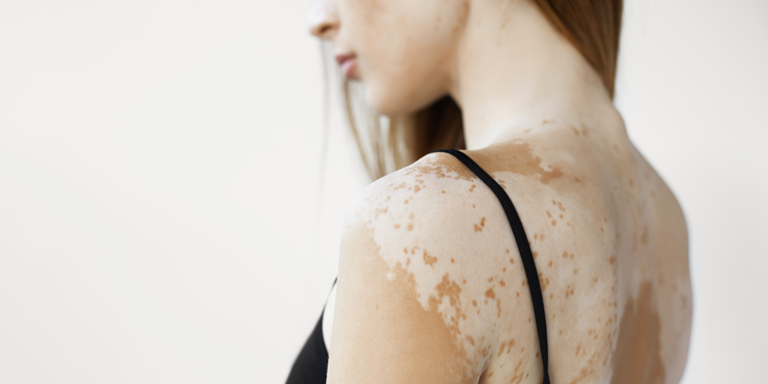Vitiligo
Vitiligo is a chronic disease characterised by patchy discolouration of the skin.

Table of contents:
The loss of pigmentation is due to the inhibition or destruction of the cells that produce melanin. The disease occurs in approximately 1% of the global population and can already onset in infancy; in approximately half of all cases it usually first appears from the age of 20.
Causes and forms
As there is a family history of the disease in approximately one third of all cases, it is likely that a predisposition to vitiligo can be inherited. However, exactly how the disease develops is still unclear.
Three hypotheses are currently being discussed:
- According to the autoimmune hypothesis, the body itself is responsible for the destruction of pigment cells.
- According to the autoaggression hypothesis, the melanin-producing cells (melanocytes) destroy themselves due to an imbalance in the cell metabolism.
- The neural hypothesis proposes that melanocytes are destroyed by substances released by skin nerves. This might explain, for example, why vitiligo progresses rapidly under stress, as these nerves are known to release more of these substances into the skin in times of stress.
It is also conceivable that all three hypotheses may be involved.
Mental stress, exposure to intense sunlight and injury to the skin may have a negative effect on the course of the disease. Hormonal changes such as in pregnancy and puberty are other possible trigger factors.
A distinction is made between localised vitiligo and generalised vitiligo:
Generalised vitiligo
In generalised vitiligo, depigmentation occurs on both sides of the body. Sufferers may experience flare-ups and these may cause the white patches to cover virtually the entire body surface.
Localised vitiligo
In localised vitiligo, the patches appear on only one side of the body. In most cases, the disease is therefore less pronounced.
Symptoms
Vitiligo is characterised by round, white, well-defined patches on the skin (depigmentation). In most cases, the skin bordering these patches is darker. Vitiligo most commonly appears on the face, neck, in the underarms, on the back of the hand and in the groin.
Diagnosis
Diagnosis is based on the typical symptoms stated above. This requires both a detailed discussion between the doctor and the parents or the sufferer and examination of the skin.
A special UV lamp, the Wood’s lamp, can be used for this purpose. In cases of doubt, a skin biopsy is also performed.
To rule out any possible concurrent diseases, blood tests are also performed.
Treatment
Vitiligo is incurable and the course is unpredictable. However, various individual treatment approaches are available, which are variably successful, depending on the form of vitiligo and where the depigmentation occurs. The face and neck often respond to treatment better than other parts of the body.
The following treatments are available for vitiligo and can often be combined:
- conventional phototherapy: external treatment of affected areas of skin with UV light over several months to stimulate the formation of melanocytes
- phototherapy with laser: use of xenon chloride excimer laser for even more targeted irradiation of affected areas of skin, also to stimulate the formation of new melanocytes
- PUVA therapy: a combined treatment involving the application of a substance (psoralen) to the skin prior to UVA irradiation to increase the skin’s sensitivity to light
- cream treatment: application to the skin of active ingredients such as cortisone, calcipotriol or pseudocatalase
- surgery: grafting of the sufferer’s own healthy cells onto diseased cells and use of melanocytes from the sufferer’s normal skin. There is currently no long-term experience with these surgical procedures and they cannot therefore be recommended at present.
Tips and tricks
- avoid exposure to UV radiation from the sun; use suntan lotions and wear comfortable and loose-fitting clothing
- use camouflage – a make-up technique – to disguise conspicuous patches.
Facts and figures
- The disease occurs in approximately 1% of the global population.
- Vitiligo can onset in infancy.
- In approximately half of all cases it usually first appears from the age of 20.
Editors: aha! Swiss Allergy Centre in co-operation with the Scientific Advisory Board.



